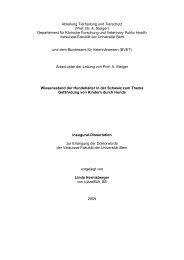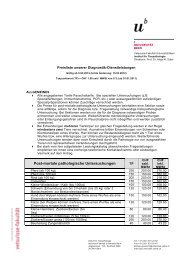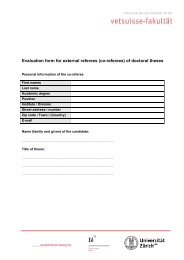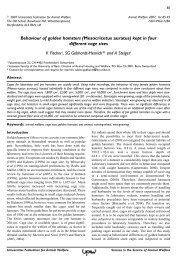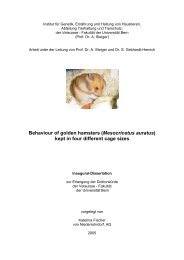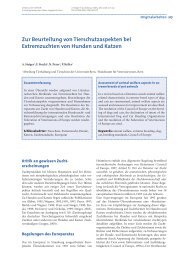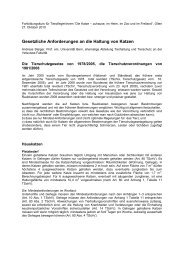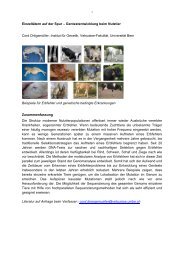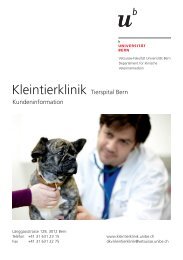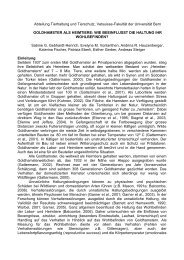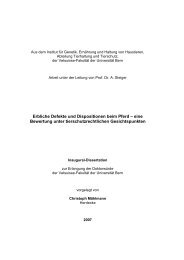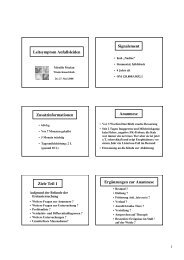Lifespan and Causes of Death in the Irish Wolfhound - Vetsuisse ...
Lifespan and Causes of Death in the Irish Wolfhound - Vetsuisse ...
Lifespan and Causes of Death in the Irish Wolfhound - Vetsuisse ...
Create successful ePaper yourself
Turn your PDF publications into a flip-book with our unique Google optimized e-Paper software.
Conservative <strong>the</strong>rapy is also <strong>in</strong>dicated to stabilise animals that exhibit signs <strong>of</strong><br />
hepatic encephalopathy before surgery is attempted <strong>and</strong> should additionally <strong>in</strong>clude<br />
fluid <strong>the</strong>rapy, normalisation <strong>of</strong> acid-base disturbances. Antibiotic treatment<br />
(neomyc<strong>in</strong>, metronidazole, ampicill<strong>in</strong>) is also <strong>in</strong>dicated to reduce <strong>the</strong> production <strong>of</strong><br />
bacterial tox<strong>in</strong>s <strong>in</strong> <strong>the</strong> <strong>in</strong>test<strong>in</strong>e (Fossum <strong>and</strong> Hedlund 2002).<br />
Surgery is <strong>the</strong> <strong>the</strong>rapy <strong>of</strong> choice, but complication <strong>and</strong> mortality rates are high. For<br />
<strong>in</strong>trahepatic PSS, postoperative complications have been reported <strong>in</strong> 77% <strong>of</strong> cases,<br />
short-term mortality is reported to range from 11% to 28% <strong>and</strong> overall mortality from<br />
23% to 63.6%. The one-year survival rate was reported as 61%, while <strong>the</strong> two-year<br />
survival rate was 55% (Papazoglou, Monnet et al. 2002). The technique <strong>of</strong> choice is<br />
reported to be direct pos<strong>the</strong>patic ligation for <strong>the</strong> left divisional shunt consistent with a<br />
persistent Ductus venosus (White, Burton et al. 1998). Ano<strong>the</strong>r reported technique is<br />
cellophane b<strong>and</strong><strong>in</strong>g, which was used <strong>in</strong> two <strong>Wolfhound</strong> puppies, one <strong>of</strong> which<br />
survived (Connery, McAllister et al. 2002).<br />
Recently, <strong>the</strong>re have been reports <strong>of</strong> successful shunt attenuations through m<strong>in</strong>imally<br />
<strong>in</strong>vasive coil embolisation <strong>and</strong> o<strong>the</strong>r occlusion techniques us<strong>in</strong>g a jugular venous<br />
approach (Leveille, Johnson et al. 2003; Weisse, Mondsche<strong>in</strong> et al. 2005). While<br />
results seem to be promis<strong>in</strong>g to-date, <strong>the</strong>se techniques should still be considered<br />
experimental at <strong>the</strong> moment given <strong>the</strong> small number <strong>of</strong> described cases.<br />
3.2.2 Epizootology<br />
PSS <strong>in</strong>cidence rates <strong>in</strong> <strong>the</strong> <strong>Irish</strong> <strong>Wolfhound</strong> population are reported to vary between<br />
2.1 <strong>and</strong> 3.4% <strong>of</strong> all puppies <strong>and</strong> 18% <strong>of</strong> all litters. Smaller litters seem to have a<br />
higher risk (Meyer, Rothuizen et al. 1995; Ubb<strong>in</strong>k, van de Broek et al. 1998 b; Kerr<br />
<strong>and</strong> van Doorn 1999). Accord<strong>in</strong>g to Hardy-We<strong>in</strong>berg (p 2 +2pq+q 2 =1 ; p+q=1), <strong>the</strong>se<br />
numbers imply a healthy carrier frequency <strong>of</strong> 24.8% to 30.1% <strong>of</strong> all <strong>Irish</strong> <strong>Wolfhound</strong>s<br />
given <strong>the</strong> mode <strong>of</strong> <strong>in</strong>heritance (see below).<br />
Fur<strong>the</strong>rmore, PSS <strong>in</strong>cidence rates <strong>in</strong> <strong>the</strong> direct descendants <strong>of</strong> certa<strong>in</strong> <strong>in</strong>dividuals<br />
have been measured to be as high as 15% (Ubb<strong>in</strong>k, van de Broek et al. 1998 a).<br />
3.2.3 Heredity <strong>and</strong> Control Measures<br />
Intrahepatic PSS has been described to be passed on <strong>in</strong> a simple autosomal<br />
recessive way (Rothuizen 2002). While <strong>the</strong> nature <strong>of</strong> <strong>the</strong> data used <strong>in</strong> <strong>the</strong> study at<br />
h<strong>and</strong> made it impossible to determ<strong>in</strong>e a mode <strong>of</strong> <strong>in</strong>heritance, <strong>the</strong> hereditary nature <strong>of</strong><br />
PSS could also be demonstrated (see Chapter 7.2.4.2).<br />
In this study, analysis <strong>of</strong> <strong>the</strong> data provided by White, Burton et al. (1998) showed that<br />
all 9 <strong>Irish</strong> <strong>Wolfhound</strong>s <strong>in</strong> <strong>the</strong>ir sample <strong>of</strong> 58 dogs with <strong>in</strong>trahepatic portosystemic<br />
shunts had a left divisional shunt consistent with a persistent Ductus venosus,<br />
whereas such a shunt was diagnosed <strong>in</strong> only 57% <strong>of</strong> all o<strong>the</strong>r dogs (P=0.02; twosided<br />
Fisher’s exact test). This fact provides fur<strong>the</strong>r evidence <strong>of</strong> a hereditary<br />
mechanism.<br />
The first published recommendation was not to breed close relatives <strong>of</strong> affected<br />
puppies (Skancke 1994). Later, it was shown that <strong>the</strong> Dutch breeders had not<br />
realised <strong>the</strong> full potential to select aga<strong>in</strong>st PSS <strong>and</strong> that <strong>the</strong> <strong>in</strong>cidence <strong>of</strong> <strong>the</strong> disease<br />
17



